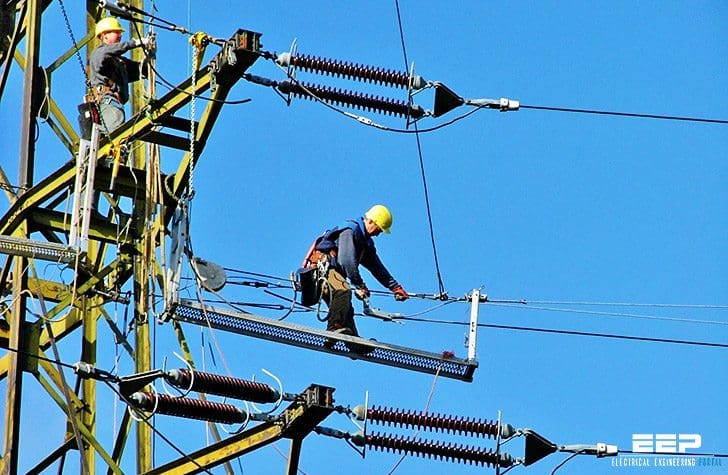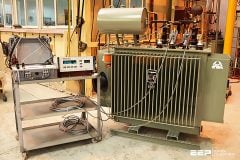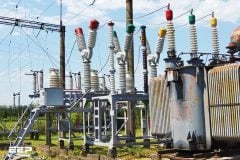Introduction to Losses
There are two types of losses in transmission and distribution line.
- Technical Losses and
- Commercial Losses.

It’s necessary to calculate technical and commercial losses. Normally technical losses and commercial losses are calculated separately.
Technical losses of the distribution line mostly depend upon electrical load, type and size of conductor, length of line etc.
Let’s try to calculate technical losses of one of following 11 KV distribution line ;)
Example – 11 kV Distribution Line
11 KV distribution line have following parameters:
- Main length of 11 KV line is 6.18 km.
- Total number of distribution transformer on feeder:
25 KVA = 3 No.
63 KVA = 3 No.
100 KVA = 1 No. - 25 KVA transformer:
– Iron losses = 100 W
– Copper losses = 720 W
– Average LT line loss = 63W - 63KVA transformer:
– Iron losses = 200 W
– Copper losses = 1300 W
– Average LT line loss = 260W - 100 KVA transformer:
– Iron losses = 290 W
– Copper losses = 1850 W
– LT line loss = 1380W - Maximum amp is 12 Amps.
- Unit sent out during to feeder is 490335 Kwh
- Unit sold out during from feeder is 353592 Kwh
- Normative load diversity factor for urban feeder is 1.5 and for rural feeder is 2.0
Calculation
Total connected load = No’s of connected transformers
Total connected load = (25×3) + (63×3) + (100×1) = 364 KVA
Peak load = 1.732 x Line voltage x Max. amp
Peak load = 264 / 1.732 x 11 x 12 = 228
Diversity factor (DF) = Connected load (in KVA) / Peak load
Diversity factor (DF) = 364 /228 = 1.15
Load factor (LF) =
Unit sent out (in Kwh) / 1.732 x Line voltage x Max. amp. x P.F. x 8760
Load factor (LF) = 490335 / 1.732 x 11 x 12 x 0.8 × 8760 = 0.3060
Loss load factor (LLF) = (0.8 x LF x LF)+ (0.2 x LF)
Loss load factor (LLF) = (0.8 x 0.3060 x 0.3060) + (0.2 x 0.306) = 0.1361
Calculation of iron losses
Total annual iron loss in KWh =
Iron losses in Watts x Nos of TC on the feeder x 8760 / 1000
Total annual iron loss (25 KVA TC) =
100 x 3 x 8760 / 1000 = 2628 KWh
Total annual iron loss (63 KVA TC) =
200 x 3 x 8760 / 1000 = 5256 KkWh
Total annual iron loss (100 KVA TC) =
290 x 3 x 8760 / 1000 = 2540 KWh
Total annual iron loss =
2628 + 5256 + 2540 = 10424 KWh
Calculation of copper losses
Total annual copper loss in KWh =
Cu Loss in Watts x Nos of TC on the feeder LFX LF X8760 / 1000
Total annual copper loss (25 KVA TC) =
720 x 3 x 0.3 × 0.3 × 8760 / 1000 = 1771 KWh
Total annual copper loss (63 KVA TC) =
1300 x 3 x 0.3 × 0.3 × 8760 / 1000 = 3199 KWh
Total annual copper loss (100 KVA TC) =
1850 x 1 x 0.3 × 0.3 × 8760 / 1000 = 1458 KWh
Total annual copper loss =
1771 + 3199 + 1458 = 6490 KWh
HT line losses (Kwh) =
0.105 x (conn. load x 2) x Length x Resistance x LLF / (LDF x DF x DF x 2)
HT line losses = 1.05 x (265 × 2) x 6.18 x 0.54 x 0.1361 /1.5 x 1.15 x 1.15 x 2 = 831 KWh
Peak power losses =
(3 x Total LT line losses) / (PPL x DF x DF x 1000)
Peak power losses = 3 x (3 × 63 + 3 × 260 + 1 × 1380) /1.15 x 1.15 x 1000 = 3.0
LT Line losses (KWh) = (PPL) x (LLF) x 8760
LT Line losses = 3 x 0.1361 x 8760 = 3315 KWh
Total technical losses =
(HT Line losses + LT Line losses + Annual Cu losses + Annual iron losses)
Total technical losses = (831+ 3315 + 10424 + 6490) = 21061 KWh
% Technical loss = (Total losses) / (Unit sent out annually) x 100
% Technical loss = (21061 / 490335) x 100 = 4.30%











sir my client want to put solar in EB SS 11KV .but he want to sell the power to the customerof they are using 33KV.so he told some loss calculated by TNEB.so how much they calculated.pls clarify
Can you provide the reference of the formulae used here? And what is the purpose of 1.05 factor taken in calculation of HT Line Loss?
Well done sir.
Please explain how you arrived at 12Amps Maximum Amp. and the values for the LT Line loss.
Thanks.
how did you get average LT line losses as 63W ,260W and 290W
how to solve it to get optimum distance ?
are the losses purely active power losses or a there is reactive power loss present as well?
Thanjks very much engineer Permer. Your case study of Distribution feeder loss calculation is very helpful. Thank you very much once again.
May I please ask for some clarifications, as follows?
1. Some calculations seems needs checking as the results does not reflect the figures calculated. Example, diversity factor calculated as 1.15 seems to be like 1.59 if correctly calculated and some more.
2. Where is the factor of 0.105 or 1.05 obtained in calculating HT line loss? Which figure is correct? 0.105 or 1.05?
3. Why is 8760 not used in calculating HT (and possibly LT line) losses to convert it to KWh?
Thanks so much for the good effort, hoping that you clarify these issues, please.
1.05 is correct. Considering line sag as 5% of total length
The actual Formula for calculating annual HT Line Loss
0.105 x(P^2 x RxLLF/(2xLDFxDF^2)
Yes, this is the actual formula.
Sir,
How to calculate the 1600KVA transformer line losses (11KV/433V), please send the step by by formulas.
what is the reason for huge transmission losses in 132kV underground cable system
please give answer in 11 kv line per meter line loss load is 7000 Amp Lt
Dear Mr. Jignesh,
It is nice meeting you, i have gone thru your blogs and find certain excel calculation sheet, actually i m looking for the excel tool for Insulation Coordination as per IEC, IEEE, IS.
Also Line loss calculation using UG cable at HV (33kV and 11kV)
You are requested to kindly post the blog on it electrical section or reply to me with returning email. It will be helpful. Alsot kindly let me the buying charges of these.
Thank you for your guide on calculating technical loss, however please I need clarification on 0.2 value used in loss load factor calculation and 0.105 used in calculating HT line losses(Kwh). Thank you
Respected sir please provide the information of 8760
8760= Number of hours in a year viz.24×365
Ht line losses, peak powe losses and lt line losses calculation has to much calculation mistake can you explain how are you finding 831- 3.0 – 3315
In Uganda my company get form Umeme 33kv. After line loss I get 28 -29 kg And my transformer set on step 5 last stape but I am not geting 415 volt. So what should I do. Please give me solution if you have.
Thank you sir for giving this information. Plz clear. In load factor it’s mentioned 8760. How, what constant.
Two Distribution transformers of 630 KVA are installed in a residential group housing society. In summer they have 60% loading and in winter they have only 30-35% loading.I want to know in winter if all load will run at one Transformer and one transformer take in idle position , how much losses we can save. LT cables will be same ,only one Transformer will be in idle position for winter period.
hi friends any buddy have IEC and other standard codes and definition
Dear Sir, do you have this article corrected? the question is because I have the same doubts with respect the ecuations and his results.
thanks in advance
Dear Sir. Thanks for your opportunity provided me to read EEP materials on line. I’m praying that one day I can get a job that will enable me subscribe as a member so that I may be able to download and read these materials daily to improve my skills as a student reading Electrical Engineering in a war ravish country Liberia where there is no research lab and internets But thanks to EEP I’m fighting hard to be myself in this my chosen career.
Best regards.
Dear sir
I want to know that, how to include line losses in grid extension feasibility study please reply
Sir, what refrence for Book of this formula ? is there from iec,ieee,or etc?
1st of all tell me about max’m Ampere i.e u have taken max’m amp as 12amps , I don’t understand that that max’m ampere is of Line Conductor or Transformer..
how max’m Ampere Will be Calculated if NOT GIVEN.
If someone Know the Answer Than Kindly Reply me… at [email protected]
Thanks for the calculations
Sir, your materials seem helpful. In your calculation of HT line losses where did the constants 0.105 from and it later transformed to 1.05. please am not too clear on this. what is the name of the constant? or is the constant meant feeder. and if its for 33kv feeder, how what will be the constant
sir i have very lack of knowledge about reactve power so kindly i request u to send some basic details regarding i hope u do the same.
dear sir i have very lack of knowledge about reactive power (kvar) so pls teach me about it ,
i am looking forward for ur valuable reply
Dear Sir,
I am very glad to have a chance sharing your knowledge.
let me know one thing from your technical losses calculation that what is the meaning of No of TC on the feeder??
I am looking forward for your valuable reply.
Sir,i want to know the loss calculation in replacement of ab cable in distribution transformer sub station.Plz give an example with % of loss.
thanking you,
Ashit Kumar Ray,CESU,Odisha.
Sir
I m working as a electrical engineer in transmission line field about 33kv and 220 kv.I have a doubt about line loss per km at both 33&220kv line and how to calculate them.I need your valuable prescription.
There seems to be many calculation errors or formula errors. Also please provide clear definition of all the constants. I am very confused.
how to find out line current for 33kv overhead transmission line for 3Km? if my power plant is 2mw.
pl mail me
Sir,
What is 0.105 constant in line loss calculation and while calculating it shows as 1.05 and also the loss while calculating it is not 831 KWh How?
please explain it
264÷1.732x11x12=228 how
hi ur providing a free and very helpfull guidline for elect engg …thanx for that sir
364 /228 = 1.15 ? not 1.6 ?
and
HT line losses = 1.05 x (265 × 2) x 6.18 x 0.54 x 0.1361 /1.5 x 1.15 x 1.15 x 2 = 831 KWh
265× 2, where it is from?
if cable size is more than actual cable (depend on rated current) so what is loss?
please give answer in technical and commercial loss.
I’m working on a project to reduce the losses in distribution lines of the city of Casablanca (Morocco). I need the methodology used in this example to perform the calculations. Thanks to send me the required elements. ([email protected])
Please, kindly assist and furnish me with the extensive list of test adopted universally performed on Power Transformers.
Thank you